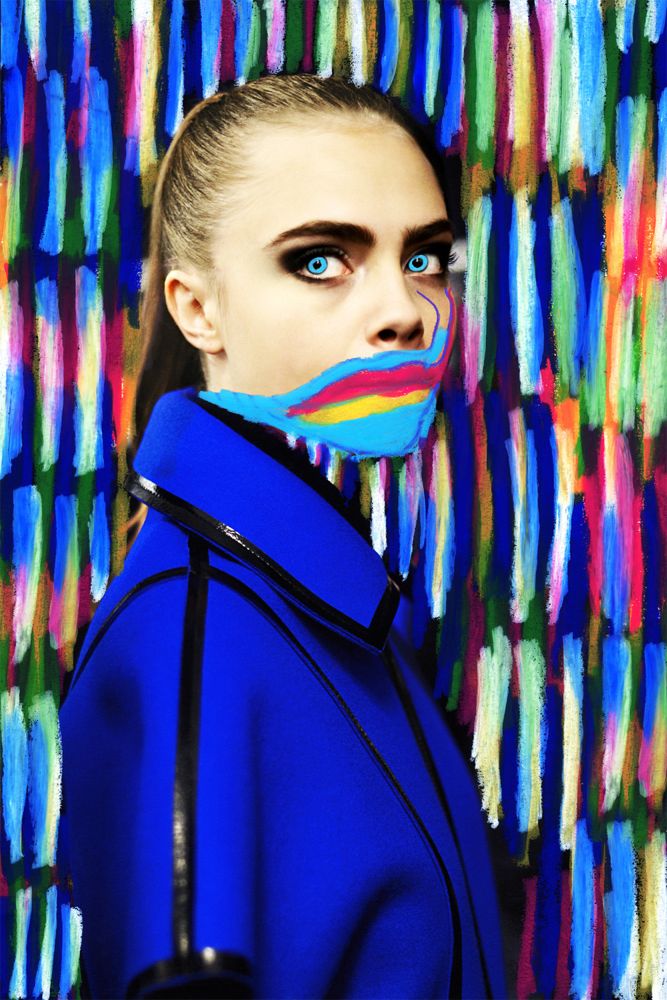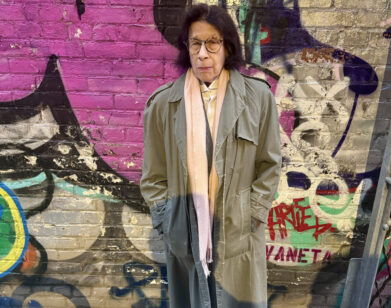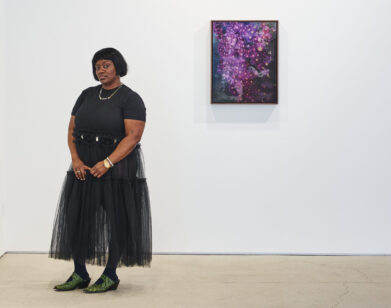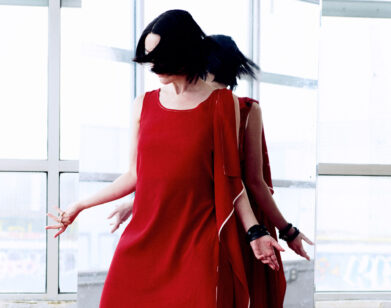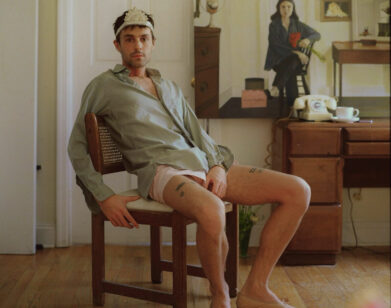The Obsessive Austyn Weiner
Austyn Weiner is a product of her environment. The 23-year-old artist’s explosive color palette comes from her hometown of Miami; the recurring lines—now Weiner’s signature—from her frantic, oversaturated New York existence. But it is the emotion evident in what Weiner does, the part she draws out from her polarized personalities, that lends her work a seductive quality. Weiner does not shy away from revealing herself within and alongside her art—her blog, Austyntatious, is filled with Instagram selfies, and she wrote the biography featured on her website rather than relying on a savvy press agent. It’s the rare young artist who’s committed to revealing her image rather than cultivating it.
Recently Weiner produced her largest work to date, an arresting 40-by-10-foot Plexiglas image. It is her first contribution to a newly formed artist collective, The Arts Initiative, conceived to fill public spaces with large-scale contemporary art. The piece now hangs at The Fashion Outlets of Chicago alongside the work of Daniel Arsham, Friends With You, and Jim Drain—just a few of the acclaimed artists who round out the collective. At the luxury outlet mall, the works can be enjoyed by fine art enthusiasts and nine-year-old mallrats alike, in keeping with the initiative’s goal of making art a part of everyday life. The youngest and least established artist involved, Weiner did not succumb to intimidation. True to form, she became a student of her surroundings and, as she so often does, reveled in some social-media-documented fun along the way. We caught up with the artist to chat about The Arts Initiative, producing autobiographical work, and shooting Cara Delevingne.
ALLYSON SHIFFMAN: How did you come to be involved in The Arts Initiave?
AUSTYN WEINER: I’m from Miami, born and raised, and the curators of this mall project are from Primary Flight, an unbelievable gallery in Miami. All of the artists they approached were somehow related to Miami, whether they had their big break there, were born there, or went to school there. So it had this real family dynamic, because everybody ended up connecting on a level beyond the arts. I was the first install, and when I was planning the project in my head, I thought I would want to be in and out so I could go party all summer, but then I went up there and fell so in love with this environment. We were living in a hotel 50 feet from the mall, so essentially we were in a parking lot in this town outside Chicago. For me, being such a young, emerging artist getting to build relationships with these artists and curators… I broke all of my other summer plans and moved up there for two months until the project opened.
SHIFFMAN: How did you conceptualize this piece?
WEINER: I knew I wanted the work to be image-based, I knew I wanted it to be a portrait piece, and I knew I wanted it to be a narrative. I had written and created this short film where this girl was playing me. It’s a psychoanalytical storyline of the highs and lows of a personality. For this piece, I took apart stills from the film and stitched and layered them to create a narrative where it is this same girl in three different settings. I created all of the work off-site and freighted it to Chicago, so once I got there all I had to do was install it, but every artist was different. There was one artist, Andrew Nigon, who was there for six weeks. He constructed these plaster balloons that looked like they were deflated. After the first install, I helped other people out. The only other female artist in the project was Jen Stark, and I helped her paint her mural because she did a lot.
SHIFFMAN: I can imagine. Her work is very meticulous.
WEINER: After two days of working on her mural I was thinking, “Maybe I shouldn’t have volunteered.” [laughs] But no, it was great. I felt a little sad that I wasn’t physically painting anything, so it was amazing to have both experiences. It was cool to be in this artist community where we were doing nothing but creating these works.
SHIFFMAN: Was it daunting being the freshest face among all these established artists?
WEINER: There were a few moments in the beginning, but I loved it. I’m most comfortable playing the sponge role, just sitting back and taking in everything. So that’s what I did, I was just learning. And the way that they responded to my work was so constructive. It was interesting to see what else is out there and where my work could potentially fill a void—a space that hasn’t been filled yet. Being close to all these artists and their work really helped me to refine what it is I want to do.
SHIFFMAN: Of all the artists involved, whose work stands out as having had the greatest impact on you?
WEINER: Daniel Arsham’s work was the most important to me.
SHIFFMAN: That’s funny, because what you do as artists is so drastically different.
WEINER: We could not be more different. He’s minimalist and I’m excessive. I learn from those types of people more than I learn from someone I have something in common with. His use of material and attention to construction has made me push the idea of an image. My new body of work is going to feature a lot of sculptural elements and pushing the idea of an image physically. Having the opportunity to spend time with him was unbelievable. He, as a person, is his artwork.
SHIFFMAN: I wanted to talk about the notion of young artists being tied to their work. You seem fearless in putting yourself out there alongside your art. Do you ever have any hesitations or fears about this?
WEINER: I think these days with social media, creating your image is such a weird thing. I have so many sides to me—so many personalities that I live with. The thing I think about when I’m about to put a picture up or expose myself is that the “fine art world” doesn’t have that connection between the artist and the art; people believe the work should stand alone. I don’t look at art like that. I think an artist can be as much or as little a part of their work as they want to be.
SHIFFMAN: There is a history of artists in the fine art realm exploring facets of themselves in their work. Look at Cindy Sherman and Nan Goldin.
WEINER: Yes, and I think one day I will turn the camera on myself. I’ve played around with the idea of performance art. Right now, it’s so interesting to me to have other people play these facets of my personality. But it’s just not like me to put something on a white wall and walk away from it. I’m very connected to my work, and I think honesty within artwork is so evident. If you’re not being honest, personally, I’m not interested.
SHIFFMAN: You’ve said that coming from Miami has had a great affect on your work. How did growing up there shape your aesthetic?
WEINER: I was a photographer first. I picked up a camera at 14 years old, and I was that creepy girl that never put it down. Miami is bursting with color, so things I was attracted to were vibrant and eccentric. It’s an extremely eclectic place; every color, every person, every race, every nationality is represented in this beautiful and romantic light. My aesthetic was very much developed there.
SHIFFMAN: And has living in New York had an impact on you as an artist as well?
WEINER: I’ve lived a lot of places, but New York is a whole other beast. It affects you in ways you couldn’t possibly anticipate. One day I was walking on Bleecker Street in the West Village an I saw these two homeless men sleeping and this one photograph; the lighting, the clothing, their placement, this moment changed me as an artist. I worked on that one image for 10 months; cutting it up, painting on it, scanning it, multiplying it.
SHIFFMAN: I picture you having this obsessive Howard Hughes moment.
WEINER: I’m very obsessive-compulsive. So this really got me going in the style of work that I’m making now. I really thought I was going to be a photographer. Annie Leibovitz and David LaChapelle are my idols. I sound like a grandma when I say this, but when the digital revolution happened and everybody became a photographer, I felt like this deconstructing of imagery was my way of making a unique photograph.
SHIFFMAN: What is coming up next for you?
WEINER: I’m doing a charity event called Artworks for a Cure in Santa Monica for AIDS awareness. I’m donating a huge piece: my first large-scale light box. There are talks of my first solo show, a traveling show starting in New York during Fashion Week in February. I’ll definitely have work up for Basel.
SHIFFMAN: It’s probably no coincidence that your solo show would be during fashion week as some of your work has a fashion quality to it, like the images of Cara Delevingne, for example.
WEINER: Well again, I’m so impressionable. I take in what I surround myself with. Both of my sisters are in the fashion industry, one is the senior accessories editor at Harper’s Bazaar and the other is the Global Digital Director of Michael Kors. I haven’t been fashion-oriented, but there’s something that’s very glossy about my work. There are people I would love to work with, like Georgia May Jagger, but it has to be personal. I only want to work with people that reflect something that is me. So essentially, all of those images are still self-portraits.
SHIFFMAN: What do you and Cara have in common?
WEINER: I met Cara at a party in Brooklyn and I didn’t know how old she was. Cara, like me, comes from a big family with three sisters that possess this fashion-forward quality and she is this renegade nut. She envisions something different for herself and she’s sought it out. That sort of misfit is what I relate to. She’s a 20-year-old wild child who has paved her own way in a difficult space.
SHIFFMAN: What is the ultimate goal of your art?
WEINER: I just don’t want to see the images that I see everywhere anymore. I want to make fresh images and whatever way I have to do that, that is what I do.
AUSTYN WEINER’S PIECE FOR THE ARTS INITIATIVE IS CURRENTLY ON DISPLAY IN CHICAGO. FOR MORE ON WEINER, VISIT HER WEBSITE.

